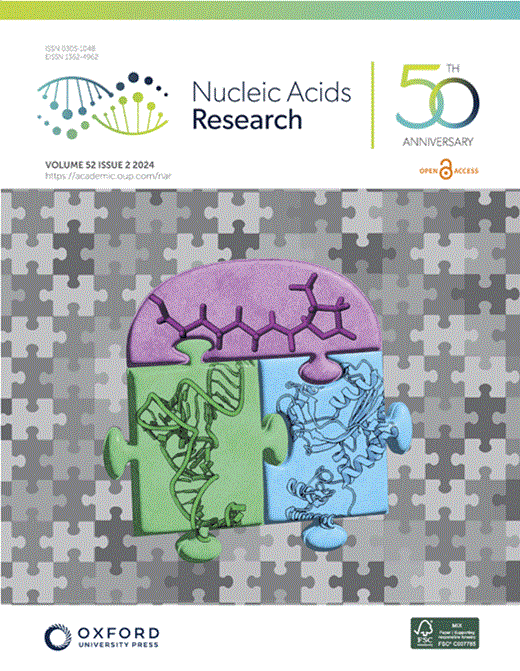DuplexDiscoverer: a computational method for the analysis of experimental duplex RNA–RNA interaction data
IF 16.6
2区 生物学
Q1 BIOCHEMISTRY & MOLECULAR BIOLOGY
引用次数: 0
Abstract
For a few years, it has been possible to experimentally probe the universe of cis and trans RNA–RNA interactions in a transcriptome-wide manner. These experiments give rise to so-called duplex data, i.e. short reads generated via high-throughput sequencing that each encode information on a cis or trans RNA–RNA interaction. These raw duplex data require complex, subsequent computational analyses in order to be interpreted as solid evidence for actual cis and trans RNA–RNA interactions. While several methods have already been proposed to tackle this challenge, almost all of them lack one or more desirable feature—computational efficiency, ability to readily alter the main processing steps and parameter values, p-value estimation for predictions, and interoperability with the common bioinformatics tools for transcriptomics. To overcome these challenges, we present DuplexDiscoverer—a computational method and R package that allows for the efficient, adjustable, and conceptually coherent analysis of duplex data. DuplexDiscoverer is readily adaptable to analysing data from different experimental protocols and its results seamlessly integrate with the most commonly used bioinformatics tools for transcriptomics in R. Most importantly, DuplexDiscoverer generates predictions that are of superior or comparable quality to those of the existing methods while significantly improving time and memory efficiency.DuplexDiscoverer:分析双链 RNA-RNA 相互作用实验数据的计算方法
几年来,人们已经可以通过实验,在整个转录组范围内探究顺式和反式 RNA-RNA 相互作用的全貌。这些实验产生了所谓的双链数据,即通过高通量测序产生的短读数,每个读数都编码了顺式或反式 RNA-RNA 相互作用的信息。这些原始双工数据需要复杂的后续计算分析,才能被解释为顺式和反式 RNA-RNA 相互作用的确凿证据。虽然已经有几种方法被提出来应对这一挑战,但几乎所有的方法都缺乏一个或多个理想的特征--计算效率、随时改变主要处理步骤和参数值的能力、预测的 p 值估计,以及与转录组学常用生物信息学工具的互操作性。为了克服这些挑战,我们提出了 DuplexDiscoverer--一种计算方法和 R 软件包,可以对双链数据进行高效、可调整和概念一致的分析。最重要的是,DuplexDiscoverer 生成的预测质量优于或可媲美现有方法,同时显著提高了时间和内存效率。
本文章由计算机程序翻译,如有差异,请以英文原文为准。
求助全文
约1分钟内获得全文
求助全文
来源期刊

Nucleic Acids Research
生物-生化与分子生物学
CiteScore
27.10
自引率
4.70%
发文量
1057
审稿时长
2 months
期刊介绍:
Nucleic Acids Research (NAR) is a scientific journal that publishes research on various aspects of nucleic acids and proteins involved in nucleic acid metabolism and interactions. It covers areas such as chemistry and synthetic biology, computational biology, gene regulation, chromatin and epigenetics, genome integrity, repair and replication, genomics, molecular biology, nucleic acid enzymes, RNA, and structural biology. The journal also includes a Survey and Summary section for brief reviews. Additionally, each year, the first issue is dedicated to biological databases, and an issue in July focuses on web-based software resources for the biological community. Nucleic Acids Research is indexed by several services including Abstracts on Hygiene and Communicable Diseases, Animal Breeding Abstracts, Agricultural Engineering Abstracts, Agbiotech News and Information, BIOSIS Previews, CAB Abstracts, and EMBASE.
 求助内容:
求助内容: 应助结果提醒方式:
应助结果提醒方式:


